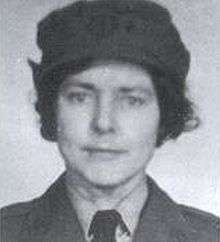Cecily Lefort
| Cecily Lefort | |
|---|---|
 Cecily Lefort | |
| Nickname(s) | Agent Jockey, Alice |
| Born |
30 April 1900 London, England, United Kingdom |
| Died |
February 1945 (aged 44) Ravensbrück concentration camp, Germany |
| Allegiance | United Kingdom, France |
| Service/branch |
Special Operations Executive, Women's Auxiliary Air Force |
| Years of service | 1941-1942 (WAAF)/1942-1945 (SOE) |
| Unit | Jockey |
| Awards | Croix de Guerre, Mentioned in Dispatches |
Cecily Lefort (30 April 1900 – February 1945) was a British SOE agent during the Second World War.
Early life
Born as Cecily Margot MacKenzie in London of Scottish ancestry, she lived on the coast of Brittany in France from the age of 24 with her French husband, Dr. Alex Lefort.
Espionage service
Lefort and her husband fled to England after Germany invaded France. Before leaving, the couple arranged for their home in Brittany be made available to the French resistance. It was used by the maquis in its escape line for downed British airmen and others needing to get out of occupied France.
In 1941, Lefort joined the British Women's Auxiliary Air Force. The following year, being fluent in the French language, she volunteered to serve with the F Section (France) of the Special Operations Executive based in London. After passing her selection board for field work, Lefort was trained as an espionage agent.
France
On the night of 16 June 1943, with fellow SOE agents Diana Rowden and Noor Inayat Khan, she was flown to Le Mans where they were met by Henri Dericourt. She was sent to southeastern France where she worked as a courier for the "Jockey network" run by Francis Cammaerts.
Arrest, imprisonment & death
Lefort was arrested by the Gestapo while meeting a contact in Montélimar in Drôme on 15 September 1943. She was sent north to the Fresnes prison in Paris where she was subjected to brutal interrogation and torture. A few months later in early 1944, she was shipped to Ravensbrück about 50 miles from Berlin. The Nazi concentration camp held approximately 30,000 women and children. With the defeat of the Third Reich becoming more and more imminent, the camp had become a frantic killing centre.[1] Lefort - along with other prisoners - was made to do hard labour for hours such as paving streets by pulling a huge iron roller. By the end of 1944, she was suffering from extreme malnutrition, diarrhoea and exhaustion.
In early 1945, she volunteered to be transferred to a new camp which SS-Obersturmführer Johann Schwarzhuber - the recently arrived deputy commandant of Ravensbrück - said was for sick prisoners. The new camp had been established at Uckermark on the site of a former youth camp for delinquent girls. However Schwarzhuber, who had formerly been responsible for gassings at the women's camp at Auschwitz-Birkenau, had built the camp as an extermination centre. Sometime in February 1945 Cicely Lefort died in the gas chamber .[2]
Aftermath
Three other female members of the SOE were executed by firing squad at Ravensbrück in February 1945, they were: Denise Bloch, Lilian Rolfe, and Violette Szabo.
Cicely Lefort was among 12 female British SOE F-Section agents who were executed at concentration camps. The War Office describes their deaths as Killed in Action.
Schwartzhuber was convicted by the British at the Hamburg Ravensbrück trials. He was hanged by Albert Pierrepoint in Hameln prison on 3 May 1947.
Honours
Cecily Lefort was Mentioned in Dispatches for her service to the British and honored by the government of France with a posthumous Croix de Guerre. She is recorded on the Runnymede Memorial in Surrey, England; and, as one of the SOE agents who died for the liberation of France, she is listed on the "Roll of Honor" on the Valençay SOE Memorial in Valençay, in the Indre departément of France.
| 1939–1945 Star | France and Germany Star | War Medal with Mentioned in Dispatches | Croix de Guerre (France) |
References
- Squadron Leader Beryl E. Escott, Mission Improbable: A salute to the RAF women of SOE in wartime France, London, Patrick Stevens Ltd, 1991. ISBN 1-85260-289-9
- Liane Jones, A Quiet Courage: Women Agents in the French Resistance, London, Transworld Publishers Ltd, 1990. ISBN 0-593-01663-7
- Marucs Binney, The Women Who Lived for Danger: The Women Agents of SOE in the Second World War, London, Hodder and Stoughton, 2002. ISBN 0-340-81840-9
- Sarah Helm, A Life in Secrets: The Story of Vera Atkins and the Lost Agents of SOE, London, Abacus, 2005 ISBN 978-0-349-11936-6
- Germaine Tillion, Ravensbrück, Garden City, Anchor Press, 1975. ISBN 978-0-385-00927-0
- ↑
- Germaine Tillion, Ravensbrück, Garden City, Anchor Press, 1975. ISBN 978-0-385-00927-0
- ↑ Helm, Sarah, ' If This Is A Woman. Inside Ravensbrück: Hitler's Concentration Camp for Women' (Little, Brown; London, 2015, pp.489, 496, 498, 507).